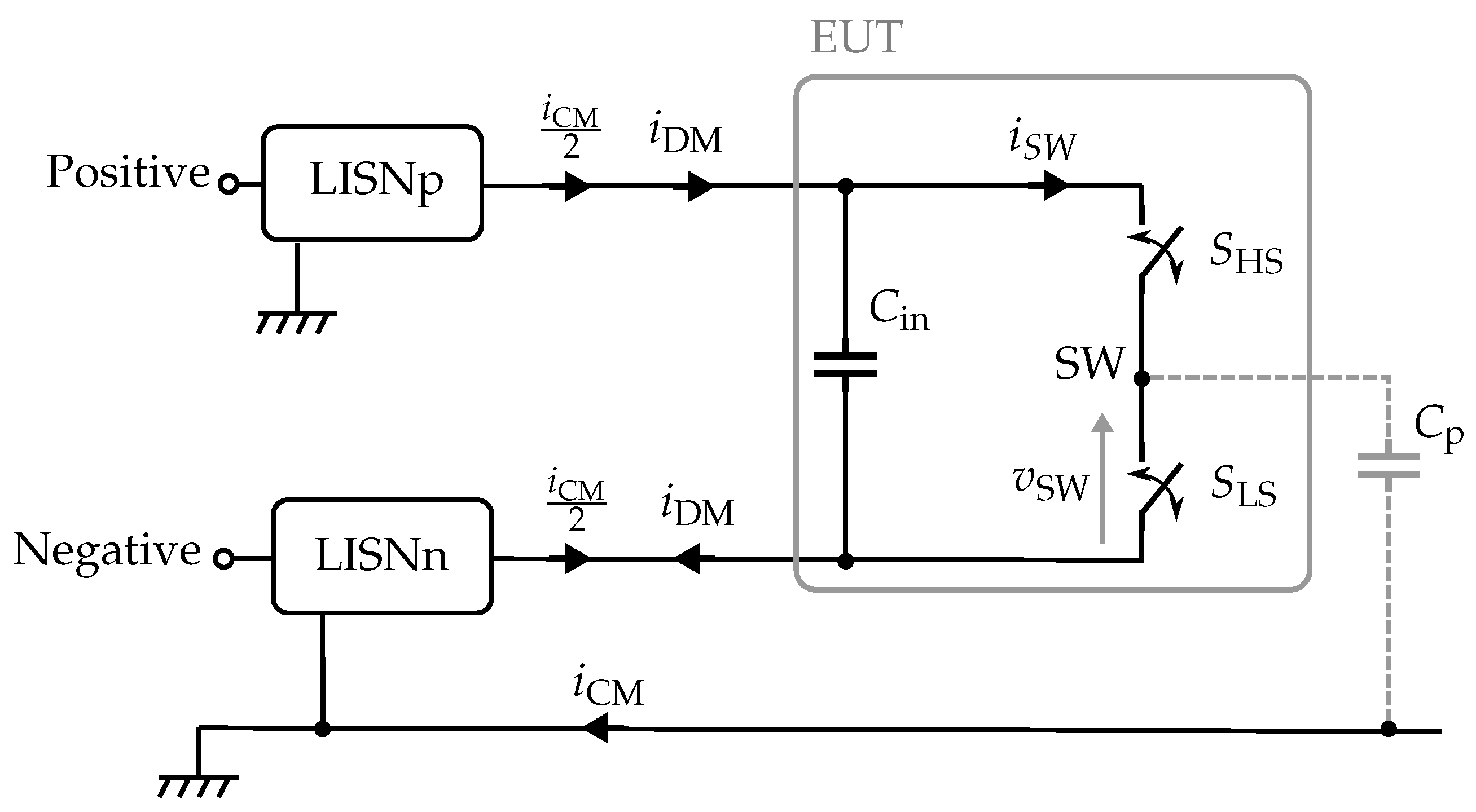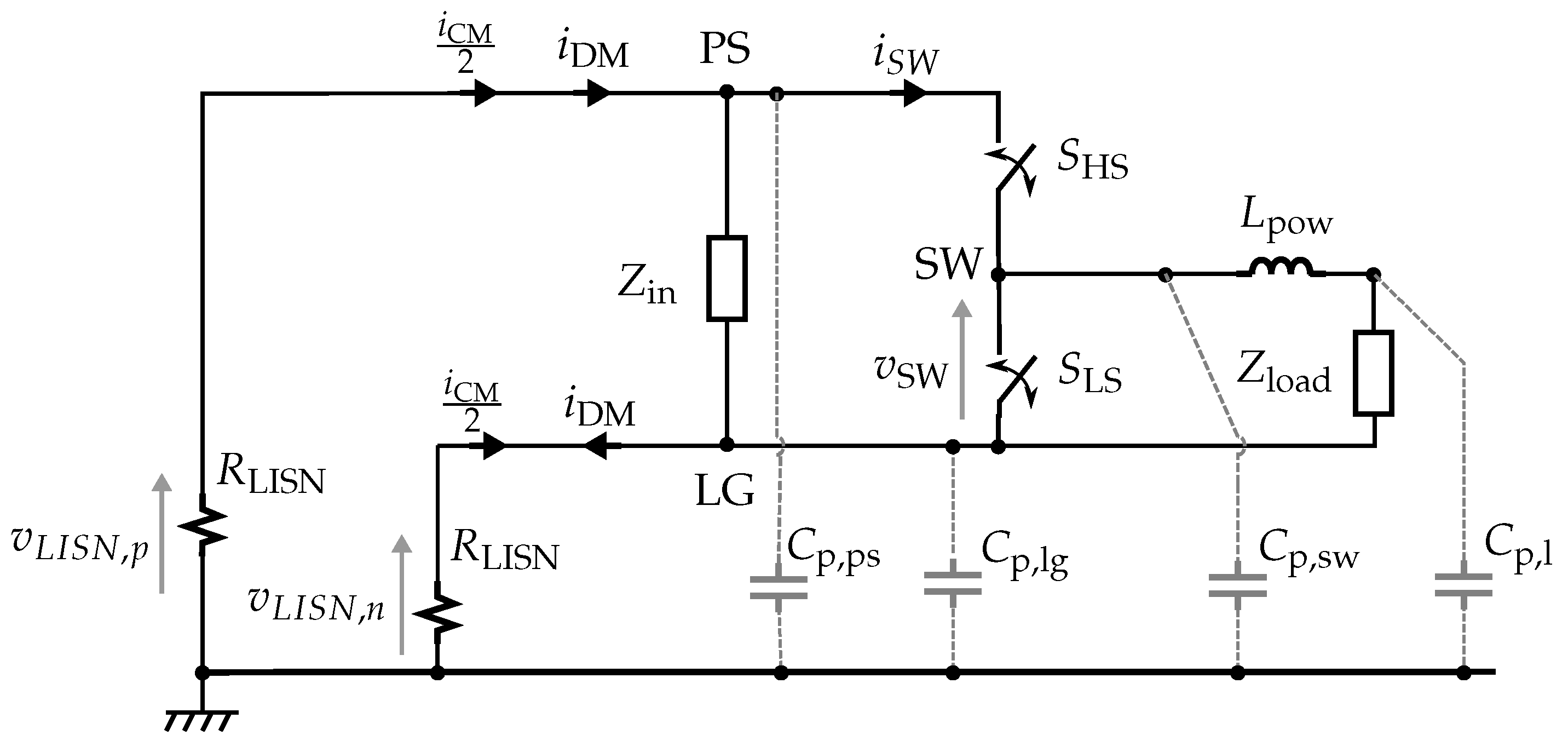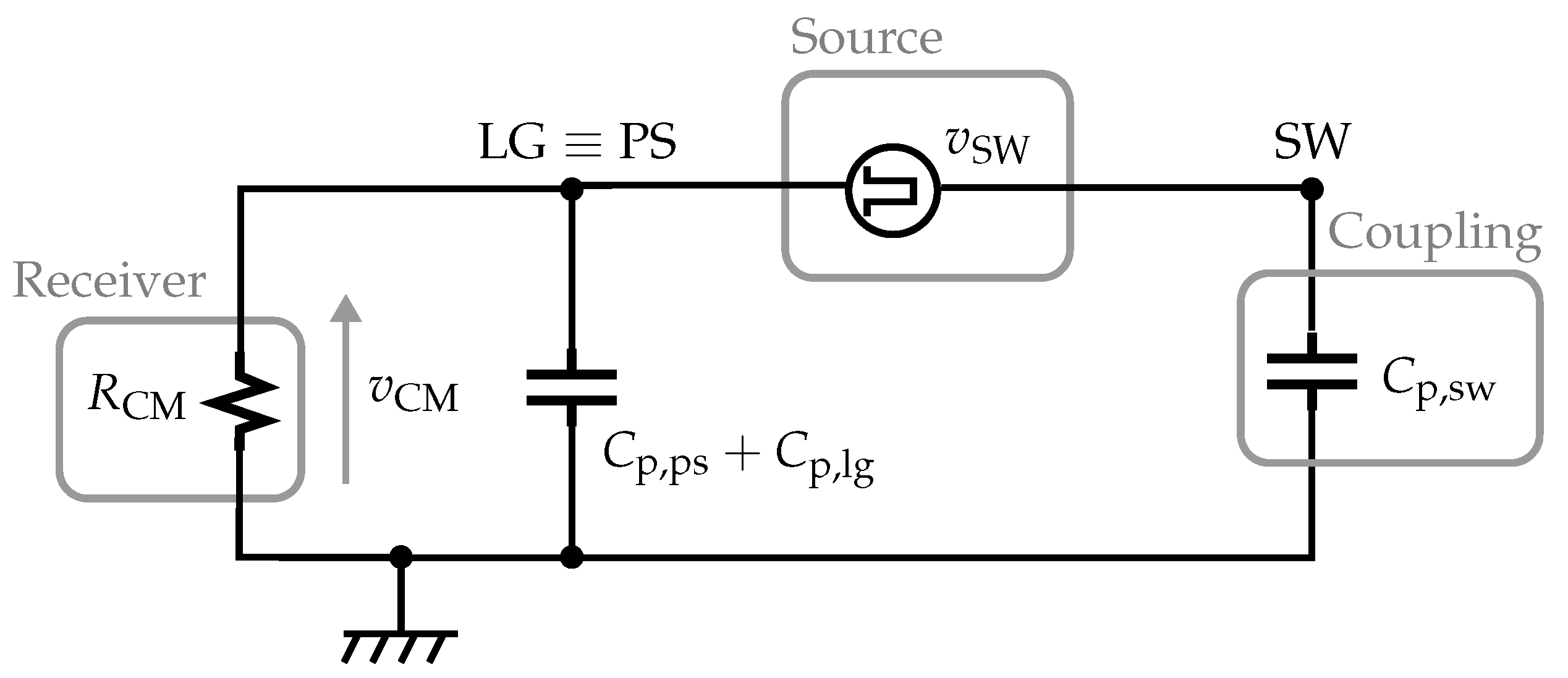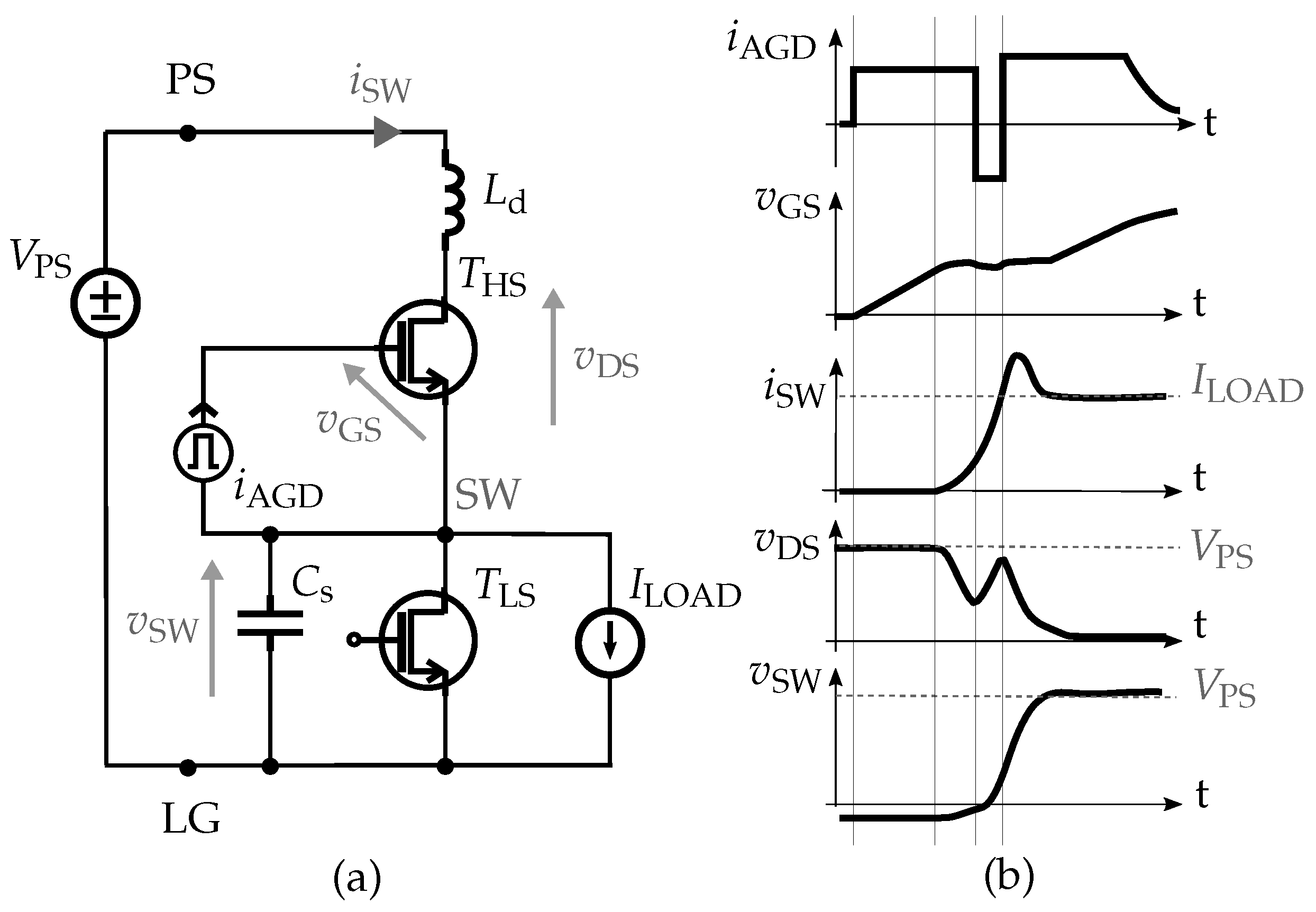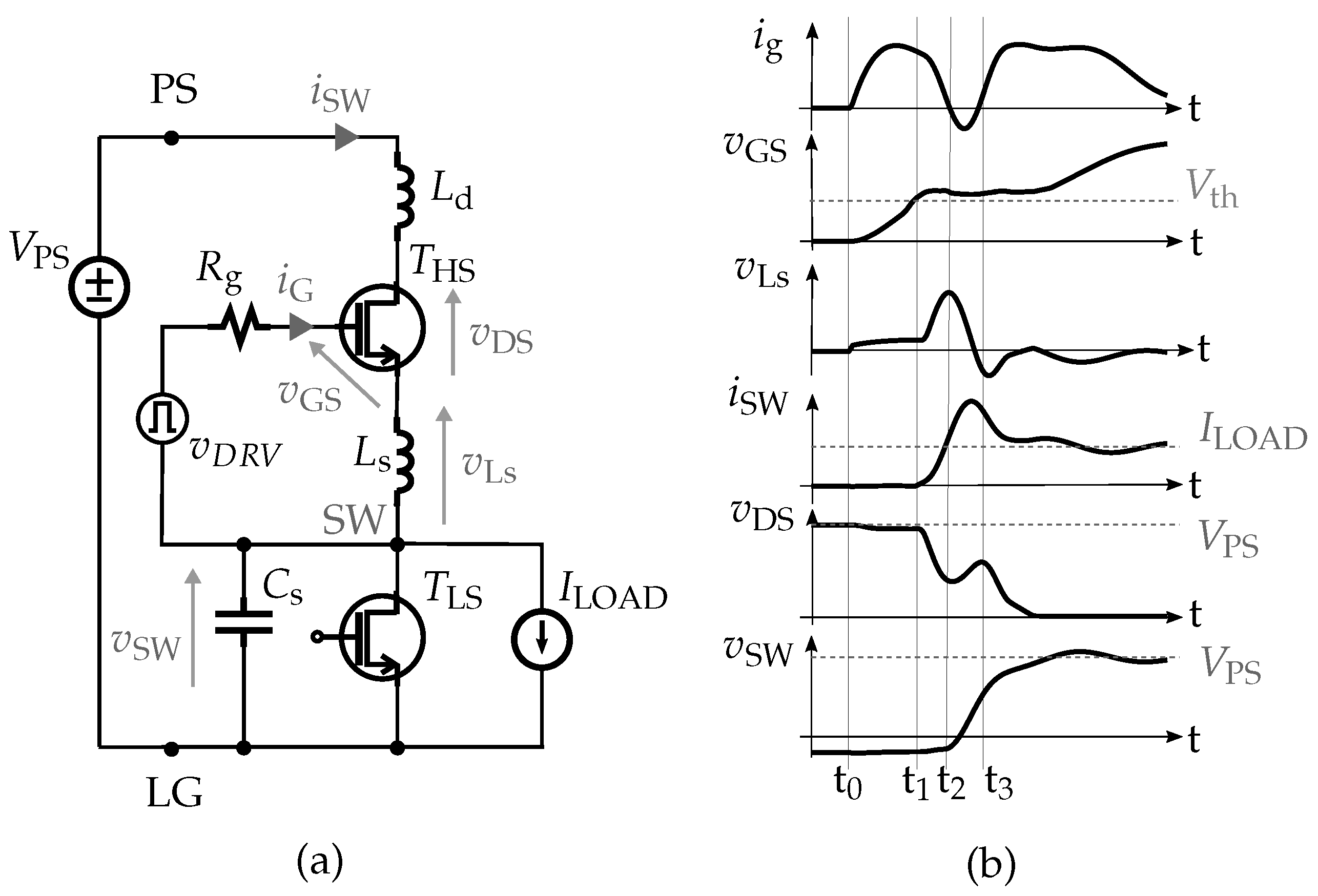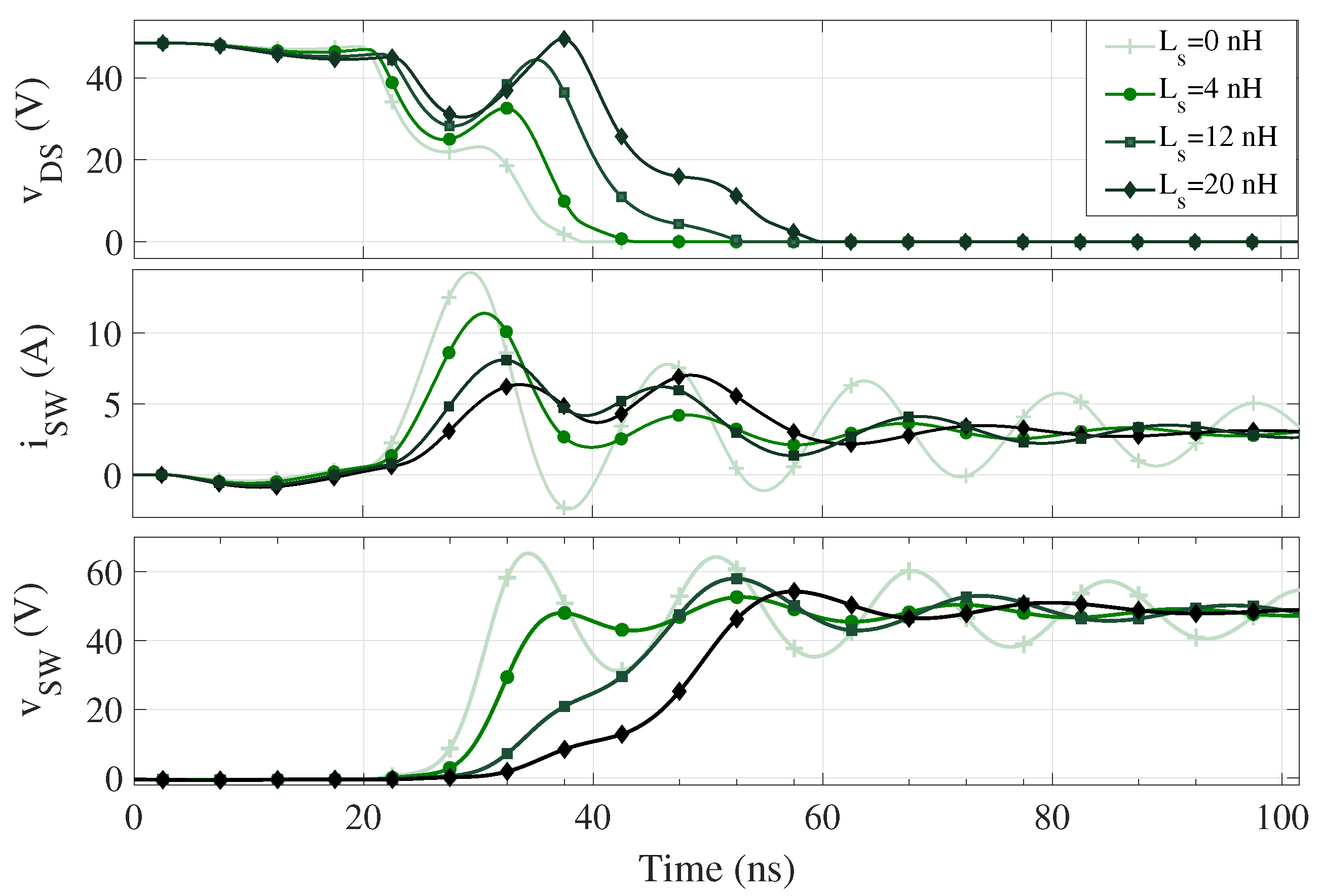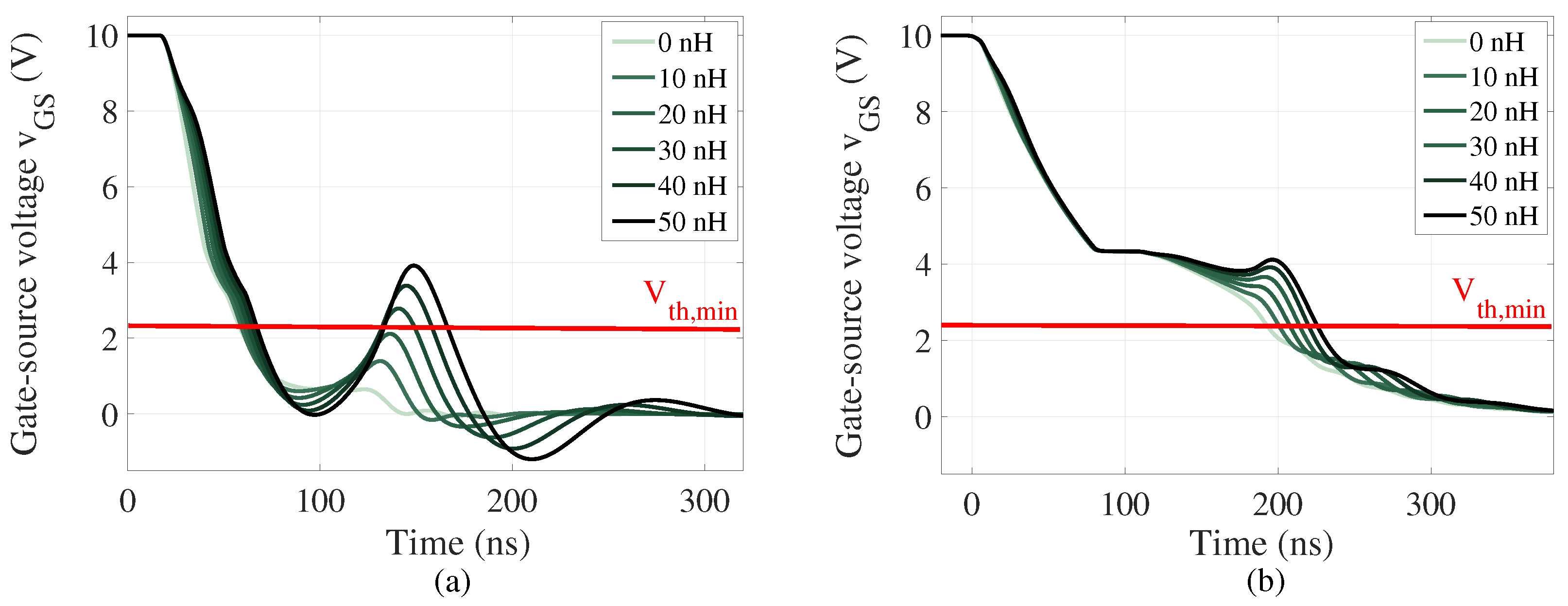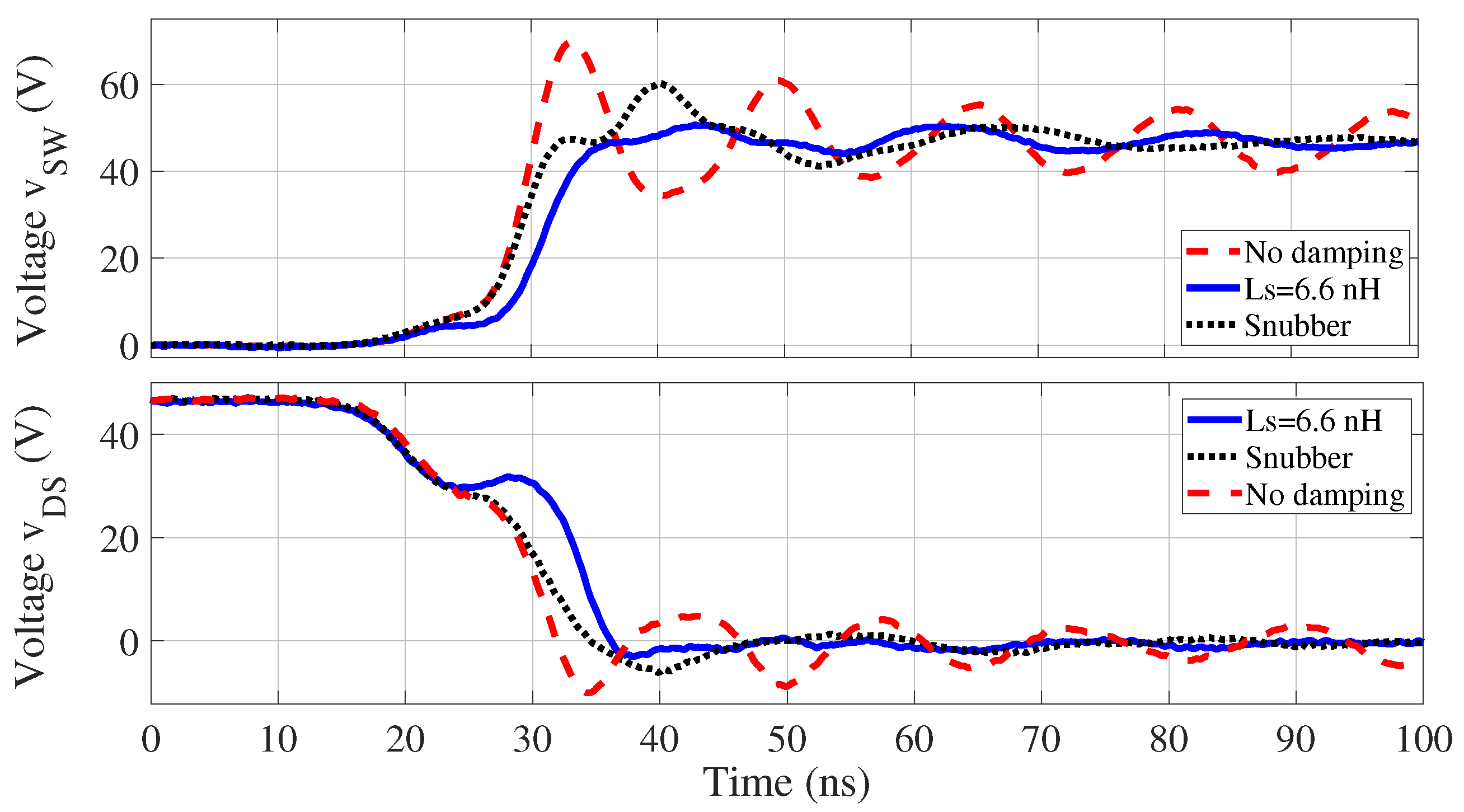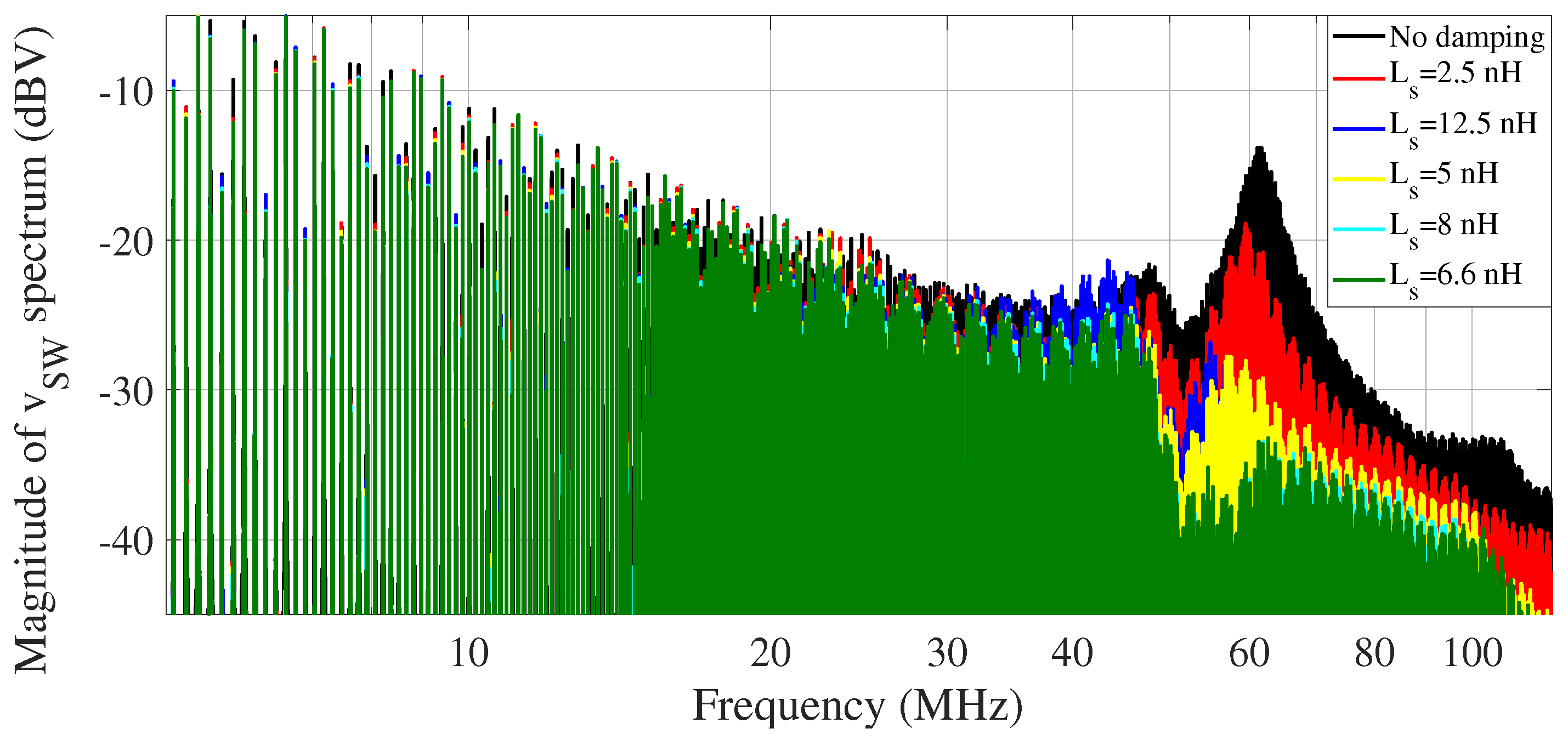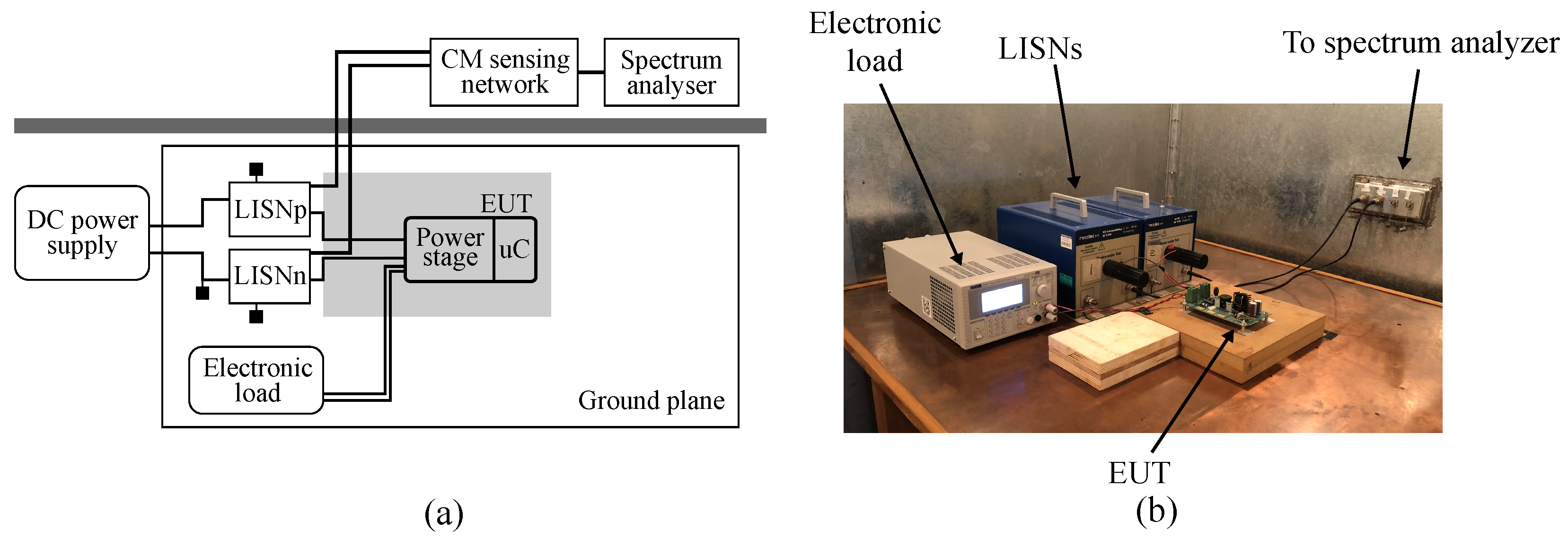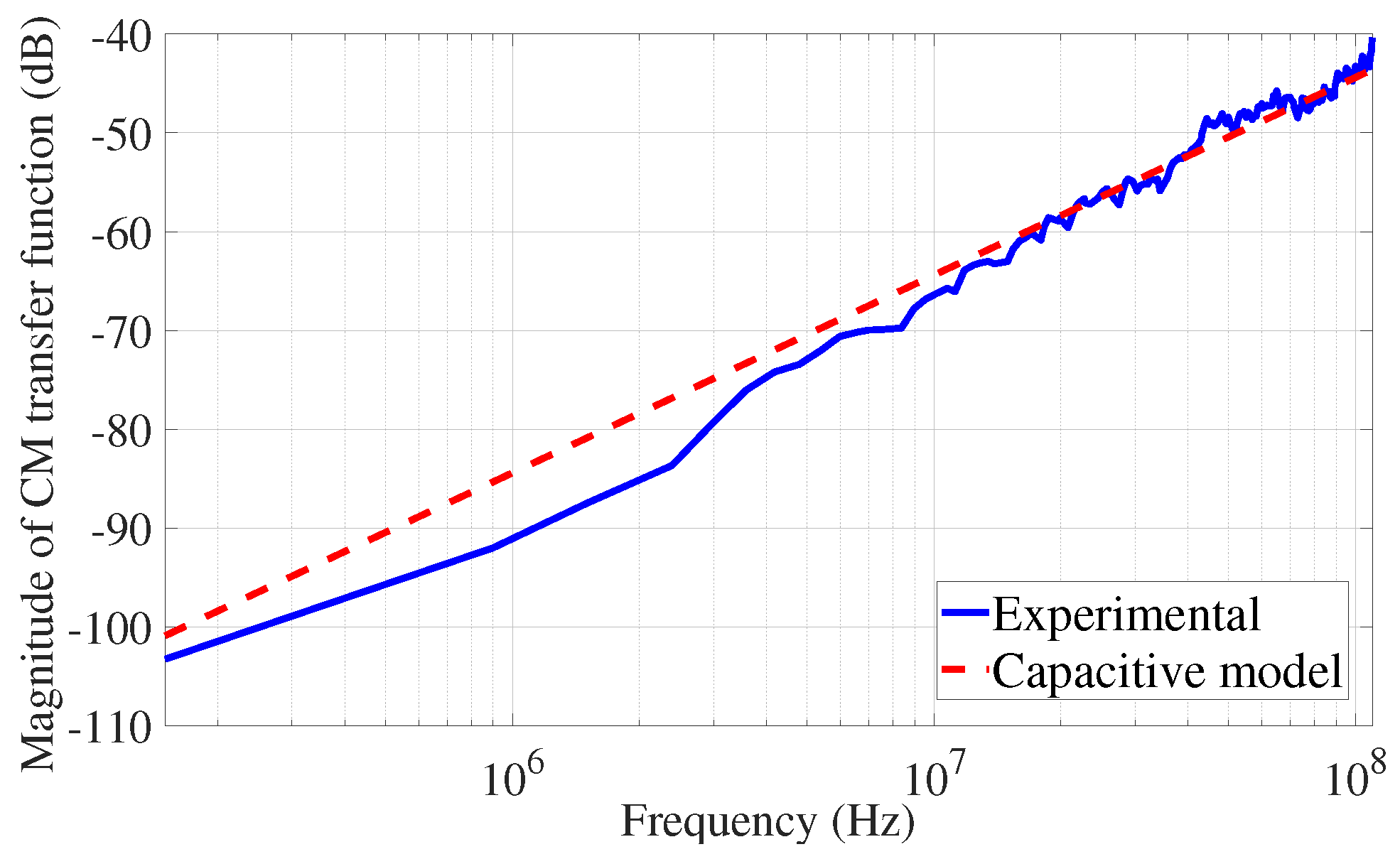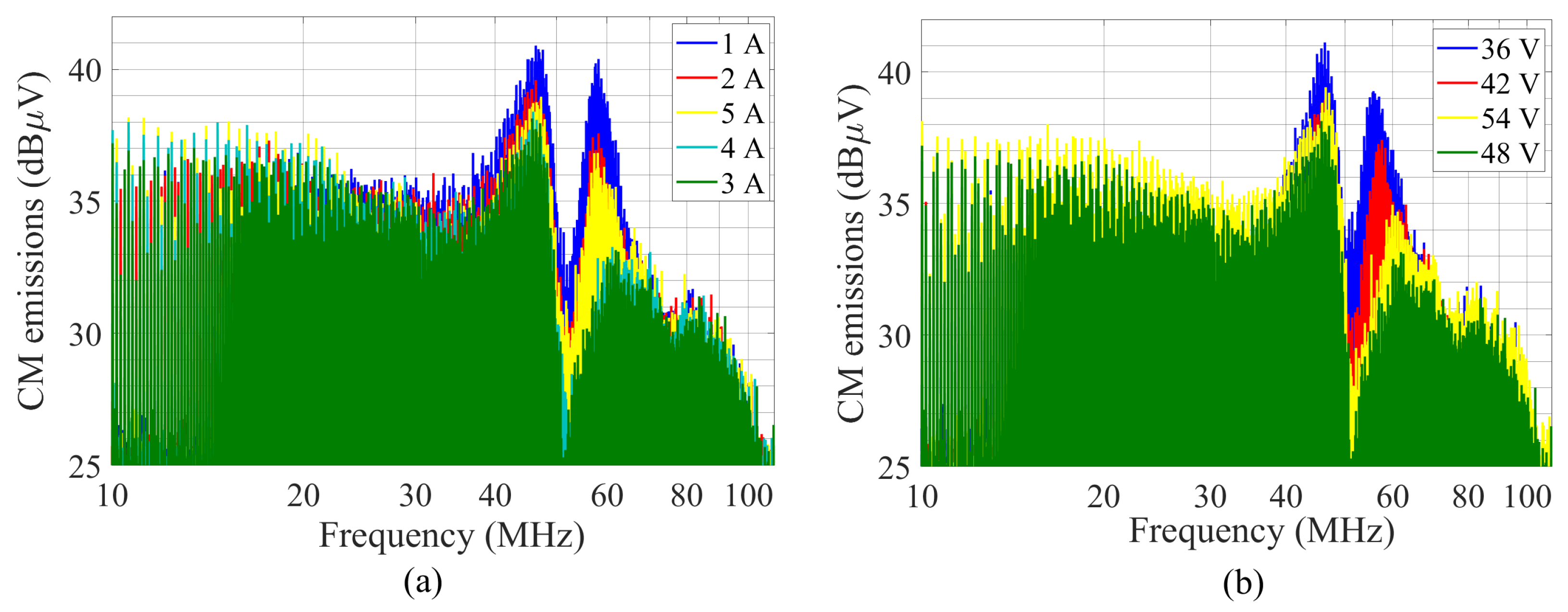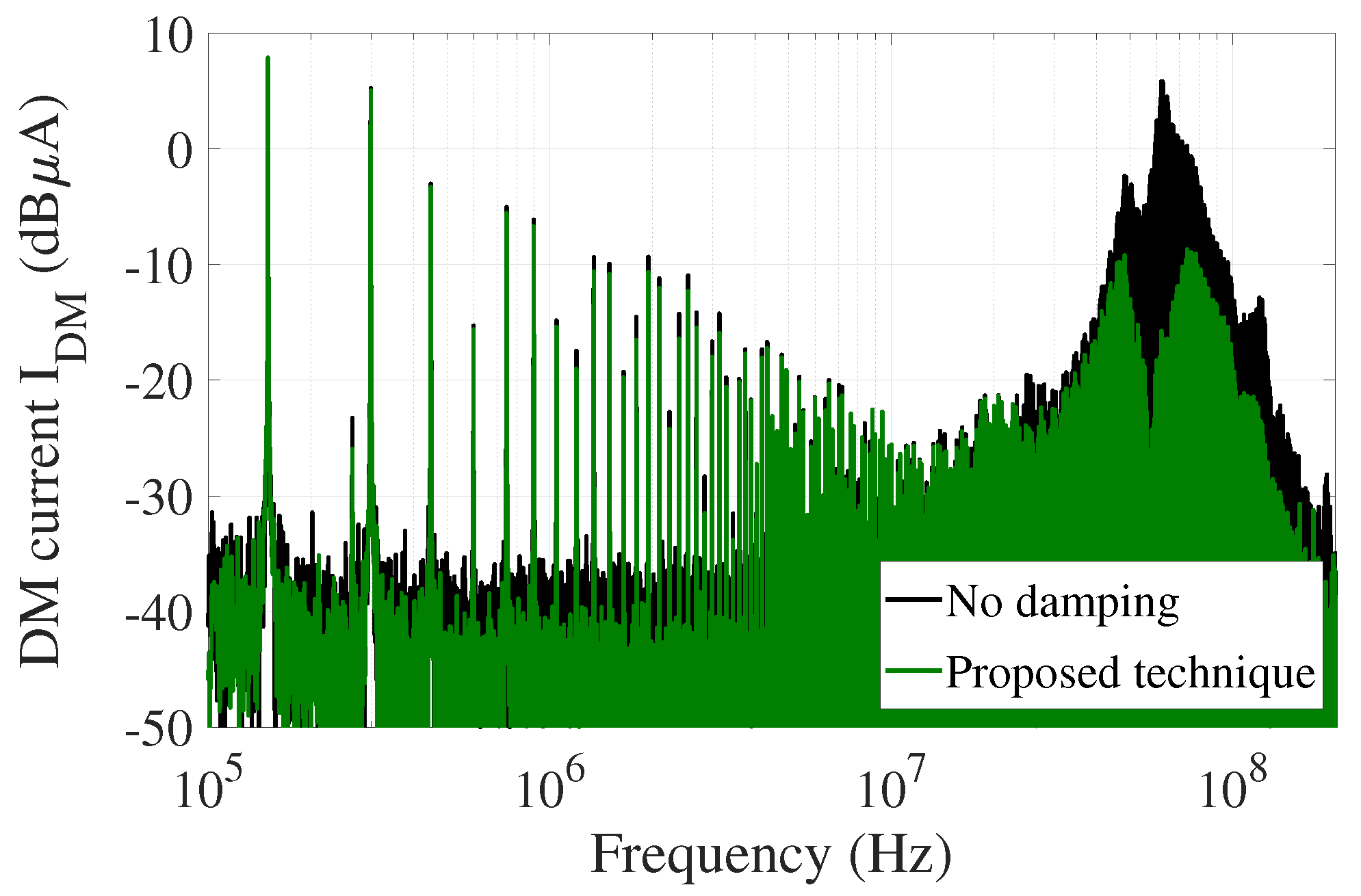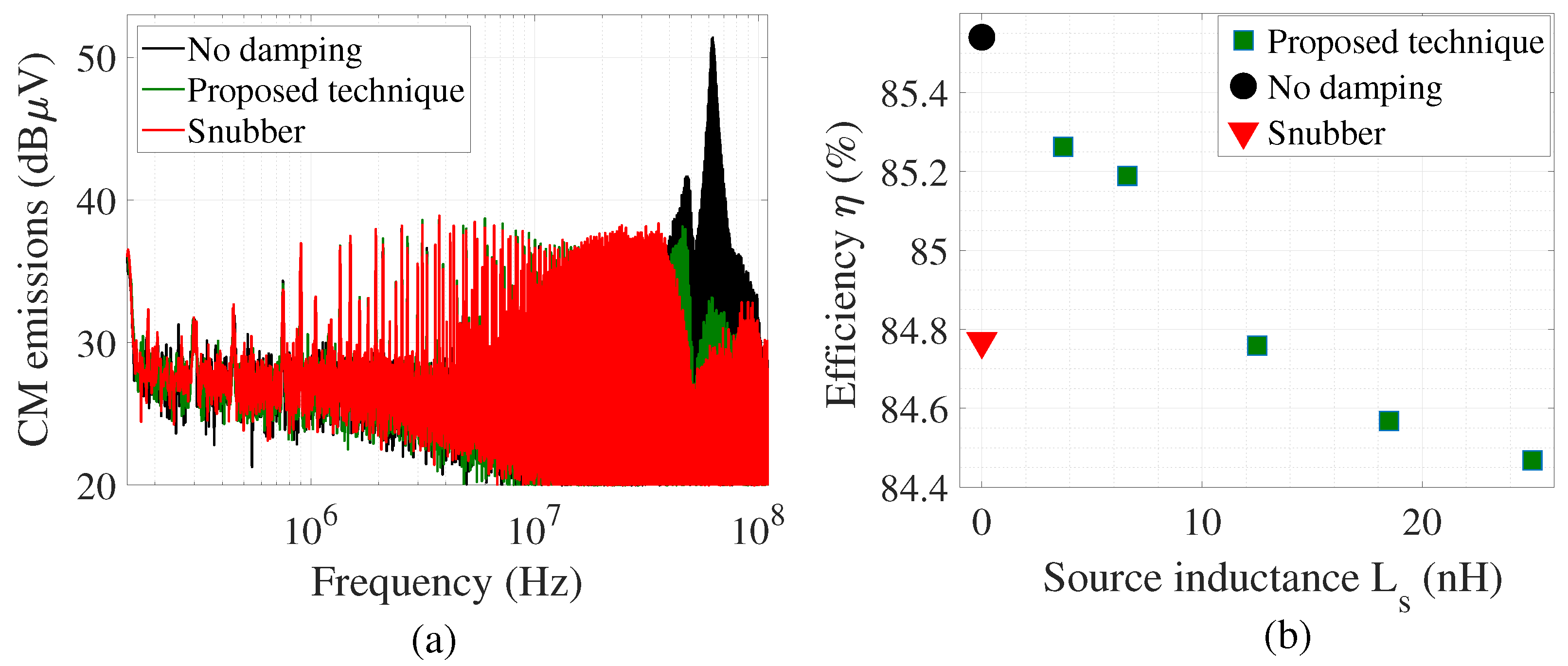1. Introduction
The continuous progress of semiconductor technologies has made possible the fabrication of increasingly faster power transistors to be used in switched power applications, e.g., motor inverters and DC–DC converters. Indeed, power designers can benefit from lower on-resistance, higher switching frequency, and smaller heat-sinks, all resulting in converter designs with higher power density. Although the pros of using more performing power switches are valuable, they are counteracted by the higher level of electromagnetic interference (EMI) they deliver, which can be attenuated quite hardly. Such an aspect can not be neglected by practitioners, since, in order for any electronic equipment to be placed on the market, it must comply with electromagnetic compatibility (EMC) standards in accordance with national or international legislation. Amongst the required EMC tests, the measurement of conducted emission aims to assess the noise current, which is delivered by the equipment under test (EUT) and it is conducted back onto the power supply system, to be within given limits. A general description of the test setup used for measuring the conducted emissions is shown in
Figure 1, where in between each power line and the EUT power supply terminal, a line impedance stabilization network (LISN) is inserted to have the impedance shown by the power supply network univocally defined over the frequency range of interest.
As far as switched power circuits are concerned, the half-bridge is identified as a root element from the EMC viewpoint, since the switched operation of the active devices it is made of, i.e., transistors and diodes, is the primary cause of the conducted disturbance current [
1,
2]. The EUT shown in
Figure 1 is modeled as a single leg and an input capacitance, which provides the switching current
during the commutations of the
and
power switches. The power supply network shown in
Figure 1 is a three-conductor system, thus the current flowing in the positive and in the negative lines can be expressed in terms of a differential-mode (DM) component (
) and a common-mode (CM) component (
). The former is due to the parasitics of the input capacitor
that cause high-frequency components
not to flow in
entirely, resulting in a DM current provided by the power line. The latter (
) is the current that flows in the ground conductor and it is related to the
affecting the
node, which causes a current to flow in the parasitic capacitance
. As far as the half-bridge shown in
Figure 1 is concerned, it is possible to identify the primary sources of EM noise as the switching current (
) for the DM EMI, and the switching voltage (
) for the CM EMI. The magnitude of the CM current usually increases with frequency as the impedance shown by the parasitic capacitance
decreases, and usually, it dominates over the DM emission in the mid-frequency range [
3], i.e., from 1 MHz to 30 MHz, where the regulatory limits are stricter. As a result, the mitigation of conducted EMI (CE) is definitely a key issue, as higher
, caused by faster power switch, results in higher emission levels.
Since the switching voltage (
) is the major source of conducted EMI, its frequency spectrum allows one to predict the CE, provided that the propagation path is known. As far as hard-switched power circuits are concerned, such a voltage can be approximated by a trapezoidal waveform, whose pulse-width (
) corresponds to the on-time of
and its high value equals to the DC voltage across
. Even though more accurate models can be considered, as in [
4], where multiple slopes are accounted for during commutations, the trapezoidal approximation results in an upper boundary of the frequency spectrum magnitude [
5]. Indeed, under the assumption that the rise time equals the fall time, i.e.,
the envelope of a trapezoidal waveform is characterized by two break frequencies, at
and
[
6]. Since typically
, it is
, meaning that
determines the high-frequency spectral content of the CM source voltage, and of the CE, eventually.
Actually, the switching voltage (
) can be affected by oscillations taking place during the switches turn-on and turn-off. More precisely, such oscillations are triggered by voltage or current steps exciting resonant circuits, which comprise the capacitive and the inductive parasitics of the power switches themselves, of the package interconnections and of the printed circuit board (PCB) layout. As a consequence, peaks at the resonant frequencies can appear in the
frequency spectrum, as well as in the
one, eventually. The superimposed oscillations also affect radiated emission, as reported in [
7,
8], thus they must be definitely avoided.
Standard solutions to reduce the amplitude of such oscillations include the use of resistor-capacitor (RC) snubbers [
9], ferrite beads or to slow down transients by means of a higher output resistance of the driver. Although the aforementioned techniques are effective in avoiding such unwanted oscillations and in reducing the delivered EMI by decreasing the dV/dt [
10], on the other side, the switching losses of the power switches increase significantly, resulting in a lower efficiency of the power circuit [
11,
12]. For such a reason, new solutions to find a better trade-off between EMI reduction and efficiency are currently being investigated. Amongst them, the use of active gate drivers (AGD) has been proven to be effective in controlling the switching trajectories of power transistors, resulting in a better compromise between overshoot reduction and switching power losses [
13,
14,
15]. The key idea of AGDs is to modify the strength of the driver during the turn-on and the turn-off of power transistors, more precisely, it is required to slow down the transistor in the middle of the commutation, while keeping fast the remainder part of the transition [
16]. In such a way, the transistor itself is exploited as a dissipative element, meaning that instead of driving it from a very high resistance, i.e., the off state, to a very low resistance, i.e., the on state, it is driven to modulate its output resistance during the commutation to avoid the oscillations from taking place. However, AGDs suffer from some major cons, as they require a complex hardware, they are not commercially available, and their tuning may be challenging to achieve if no feedback is exploited [
17]. The switching waveforms obtained using an AGD can be closely reproduced using a simpler and cheaper passive component available on the market. The key idea of the work presented in this paper is to modulate the driver strength of a high-side power transistor without using an AGD, but exploiting the source inductance. Indeed, during the transistor turn-on, such an inductance couples the power loop with the driver loop, so that the control voltage of the transistor is reduced during the transient, as in the case of an AGD. As a consequence, the switching waveforms are differently shaped with respect to a conventional gate driver, and the oscillations resulting from the excited parasitic resonant circuit are reduced. The proposed technique aims to reduce the CE delivered by a power circuit where high-side transistors are exploited, focusing on the reduction in the unwanted oscillations that take place during the high-side transistor turn-on by means of the source inductance.
The paper is organized as follows: in
Section 2 the source and the propagation path of CM conducted emissions are discussed in the case of a half-bridge, and a simplified model is presented. Then, in
Section 3, the switching waveforms of such a leg are reported in case of a conventional gate driver and of an AGD.
Section 4 introduces the effect of the source inductance and the feedback during the transistor turn-on is discussed. Then, in
Section 5, simulations on the prototyped converter are reported to investigate more deeply the source inductance effect, and a method to find its optimal value is proposed. Finally, in
Section 6, the experimental results are presented, and a comparison between the proposed technique and the use of a snubber is performed both in terms of CM EMI mitigation and efficiency. Concluding remarks are drawn in
Section 7.
2. Common-Mode Conducted Emissions of Power Switching Circuits
The source and the propagation path of the CM EMI delivered by a switching circuit are discussed in this Section. The analysis is carried out referring to the circuit shown in
Figure 2. The EUT comprises input capacitors represented by the
impedance, ideal high-side (
) and low-side (
) switches, which are connected to the output load impedance
through the inductor
. In order to simplify the analysis of the CM EMI, the EUT terminals are loaded with the LISNs impedance, which can be approximated by a
resistance in the frequency range of interest. Finally, the parasitic capacitances that load the EUT nodes toward the reference ground plane are indicated with dashed lines to be distinguished from the other components. More precisely,
connects the negative input terminal (node
) of the EUT,
the positive input terminal (
),
the switching node
and
the load to the ground plane. Moreover, the CM current (
), the DM current (
), the switching current (
), and the voltage across the low-side switch (
), which have been previously defined on
Figure 1, are depicted too.
As previously mentioned, the DM current is mainly due to the switching current
, whereas
to the switching voltage
, resulting in a current to flow in
. In order to simplify further the model shown in
Figure 2 for the analysis of the CM EMI, the DM current is not taken into account, i.e.,
. This condition is valid only if
, meaning that the switching current flows completely in the input capacitors. As far as the CM EMI is concerned, the node
is short-circuited to the node
and the impedance shown by the two LISNs is equal to
. Under these assumptions, the only current loop involved in the CM EMI is the one that comprises the LISN impedances, the low-side switch and the capacitances
. Such a loop is redrawn in
Figure 3, where the noise source
, the capacitive coupling
and the EMI receiver are clearly identified. By definition, the CM EMI voltage
is equal to
where
and
are the voltages across the measurement ports of the two LISNs, as shown in
Figure 2. The frequency spectrum of
, denoted as
in what follows, is related to the frequency spectrum of the switching voltage
according to
Typically it is
, thus the magnitude of the CM transfer function (
) can be approximated by its numerator for
, meaning that
is the only capacitance that contributes to the CM EMI in the frequency range of interest. Equation (
2) ideally allows one to predict the CM EMI provided that the frequency spectrum of
and the values of the parasitic capacitances are known. An upper bound for the
frequency spectrum is provided by the trapezoidal approximation, whereas, the value of
can be either extracted by analytical formula if the geometry is simple, as in [
1], or by using finite element simulators [
18]. Moreover, (
2) states that the CM EMI can be mitigated either by reducing the spectral content of
, by decreasing
, or by increasing
.
3. Time Domain Analysis of the CM Voltage Source
From what presented so far, the source of CM emission in a half-bridge is the voltage across the low-side power switch (
), as it causes a CM current to flow in the parasitic capacitance
and a CM voltage
on the EMI receiver, eventually. Before introducing the source inductance and its effect on
, it is convenient to introduce a detail description of the phenomena taking place during the high-side transistor turn-on. Such analysis allows one to identify the resonant circuit excited during the turn-on transient, more precisely, the circuit shown in
Figure 4a is considered. The high-side transistor is driven by a conventional gate driver (CGD) comprising of an ideal square wave voltage generator (
) and the gate resistance (
), and it is complemented by the low-side transistor (
). The power inductor (
) is modeled by the current sinker
, since the current flowing in
is subjected to much slower variations with respect to the
taking place during the transition [
19].
In addition, the active devices, the parasitic inductance
, which includes both the package interconnections and the PCB traces, is considered, as well as the parasitic capacitance
between
and
, which is due to the PCB layout. Referring to the corresponding switching waveforms shown in
Figure 4b, the
positive edge triggers the
turn-on, and after the gate source voltage (
) overcomes its threshold voltage, a positive current (
) flows in
, resulting in a linear decrease in the drain-source voltage (
). To avoid a cross-conduction current to flow in
and
, the low-side transistor is assumed to be already turned-off when the positive edge of
occurs, meaning that only its body diode should be considered in what follows.
When the current
reaches the value
, the low-side body diode turns-off and the voltage
increases, eventually. In this phase, the
diode can be modeled through its junction capacitance
, which is in parallel to the parasitic capacitance of the PCB layout (
) since it is reverse biased, resulting in a series LC resonator with the inductance
. More precisely, the voltage across the
capacitances, i.e.,
, must be charged to
. Such a voltage step may excite the resonator, and result in oscillations affecting both the switching voltage (
) and the switching current (
) at the
frequency, which is equal to
The damping factor characterizing the resonator depends on the resistive components, more precisely on the parasitic resistance of the interconnections, which is typically negligible, and the on-resistance of , provided that it is in triode when the oscillation takes place.
In addition to the use of CGD, active gate drivers (AGDs) have proofed to be effective in controlling the switching trajectories of power switches. A constant-piecewise current generator
is used for modeling the AGD, as shown in
Figure 5a. The corresponding switching waveforms are shown in
Figure 5b under the assumption that the gate current profile causes the
voltage to be critically damped, meaning that it avoids the oscillation from taking place while keeping the overall transient as fast as possible [
20]. Indeed, the gate current
affects the voltage
when the transistor is in the Miller region, since the slope (
S) of
is given by
where
is the drain-gate capacitance of
[
21]. The reduction in the
slope by means of a smaller gate current, or even a negative one, results in a
still in saturation during the rising of the voltage
. This means that by controlling the
voltage through the gate current, the oscillation can be avoided since the transistor itself is used as a dissipative element. Although
dissipates more power with respect to the CGD solution [
22], it prevents the energy bouncing between the inductive and capacitive elements of the resonator from taking place.
4. Transistor Feedback through the Source Inductance
With the aim of investigating the effects of the source inductance, the analyzed circuit is shown in
Figure 6a, where the topology previously shown in
Figure 4a is complemented with the source inductance
, and the corresponding switching waveforms are shown in
Figure 6b. In
, the rising edge of
triggers the
turn-on, so the voltage
starts to increase up to reach its threshold value
at
. The input driver loop comprises a series RLC circuit, i.e., the
inductance in series with the
input capacitance
. At
,
enters its saturation region, thus
increases, as well as the voltage across
(
), across
(
), and the voltage
eventually decreases. Under the hypothesis that the
voltage is approximately constant due to the Miller’s effect, the KVL in the input driver loop results in
meaning that, if
increases, then
decreases. The gate current decreases up to reach
in
. It is worth noticing that, even though the gate current is negative,
is still in saturation provided that
. This point (
) also corresponds to a maximum on
and
. From
,
comes negative, thus
. The drain current, however, will still increase up to reach its peak value, in
. This corresponds to
, i.e., a concavity change. From
on, the
current is again positive, thus
. The transistor will exit the Miller’s plateau and enter the triode region, eventually.
Depending on the value of
and of the
and
parasitics, the negative feedback introduced by
can slow down the transistor and suppress the oscillations. Even though the power dissipation of the high-side transistor increases when an extra source inductance is inserted [
23], it prevents the oscillation from taking place.
The exploitation of the source inductance to mitigate the turn-on oscillations, however, comes at the cost of worsening the switching performance during the turn-off, as highlighted in [
24,
25,
26]. Indeed, the unavoidable presence of the source inductance and of the gate-drain capacitance is the root cause of a cross-talk phenomenon between the input loop (gate driver) and the output loop (power loop). The most dangerous side effect of this crosstalk is the self turn-on at the turn-off transient [
27], which may result in self-sustained undampened oscillations [
28]. The self turn-on phenomenon takes place when the transistor is already off, i.e.,
, but the current flowing in the drain-gate parasitic capacitance (
) drives the gate voltage above the threshold [
27]. However, such a phenomenon can be avoided by a proper choice of the gate driver resistance, as discussed in what follows.
5. Simulation Results
Aiming to further investigate the effect of the source inductance on the switching waveforms during the transients and to provide a method to obtain the optimal
value, time-domain simulations were carried out on the circuit shown in
Figure 7. It models an asynchronous Buck converter, which was lately prototyped and exploited as EUT in
Section 6. Such a converter was designed to step down an input voltage (
) of 48 V to a 12 V output voltage, and it is able to provide the load with a maximum current of 5 A. The high-side transistor (
) is periodically turned on and turned off with a 0.25 fixed duty cycle and 150 kHz fixed switching frequency by the switches
,
, that model the gate driver output stage. The converter is provided with a set of input (
) capacitors, which lower the voltage ripple affecting the input voltage, and a freewheeling diode
, which allows the output current to flow when
is off. The simulated schematic, which is shown in
Figure 7, comprise the active and the passive devices, as well as the parasitics, which are encircled in dashed boxed to be found at a glance. The parasitics of the PCB traces (
) were evaluated from the extraction of the scattering parameters of the PCB by means of a 3D electro-magnetic simulator,
models the parasitic capacitance of the power inductor, which are not shown in
Figure 7, and it was evaluated from its resonant frequency provided by the manufacturer. The internal gate resistance
of
is equal to its nominal value, and the driver resistances
are discrete level components which can be modified. The values of the adopted components are listed in
Table 1.
5.1. Turn-On Analysis
As far as the
turn on is concerned, if the high-side transistor is driven sharply and no damping technique is exploited, i.e.,
, the switching waveforms obtained from the time-domain simulation of the circuit in
Figure 7, are shown in
Figure 8 by plus markers. Indeed, both the switching current (
) and voltage (
) are affected by oscillations at
MHz. The corresponding
voltage is not monotonic due to the
parasitic, which is however not sufficiently large to damp the oscillations. If an extra source inductance (
) is added, both the peak and the damping factor decrease with respect to the oscillating case, as for
(circle markers),
(square markers) and
(diamond markers). From such plots, it can been noticed that the higher the
is, the more the
voltage increases during the transient as the gate current is negative for a longer time. At the same time, the
rise time and the
peak, which is needed to charge the equivalent low-side capacitance to
, both decrease as
increases. Finally, from the comparison of the 4 nH and 12 nH curves, it results that a higher
value does not imply a more damped oscillation. All such aspects suggest one that the optimal value of source inductance for the simulated converter is in between 4 nH (circle markers) and 12 nH (square markers), as the rise time of
is not significantly affected by the source inductance and the oscillations are strongly reduced with respect to the oscillating case.
5.2. Optimization Method
In order to find the optimal value of source inductance to be inserted in the power loop, the method discussed hereafter is proposed. By performing parametric simulations on the
value of the circuit shown in
Figure 8, and according to [
23], it resulted that the
switching energy at the turn-on (
) linearly increase with
, as shown in
Figure 9 by the dashed line. Conversely, the
frequency spectrum should be compared against some target to determine whether the turn-on resonance is undamped or overly damped. In what follows, the frequency spectrum of an ideal trapezoidal waveform, with the same pulse-width, rise and fall time of the
obtained from the simulation, is chosen as a target. The envelopes of the
frequency spectrum (
), obtained for the different
values, were evaluated and each of them compared against the corresponding envelope of the ideal trapezoidal frequency spectrum (
), which was obtained from [
6]. Then, the ratio (
) between the envelope obtained from the simulation and the target one was evaluated at the turn-on resonant frequency as,
where
MHz is to account for uncertainties and the resonant frequency was evaluated as
since it decreases with
. For the EMI viewpoint, the optimal value of
is the one with
, as the corresponding switching waveform is the fastest and non-oscillating. The maximum ratio between such spectra was evaluated for
in the (0,34) nH range and it is shown in
Figure 9 by solid line. In the case of no source inductance added (
), the frequency peak is approximately 15 dB higher than the expected one, and two point with
exist, i.e.,
and
. As
is 3
in the case of
, which is approximately 1.4 times smaller than in the 22 nH case, the optimal value of source inductance is
= 6 nH.
5.3. Turn-Off Analysis
Although the proposed technique is effective in damping the turn on oscillation, an increase in the source inductance may lead to the self turn-on of
during its turn off. The circuit shown in
Figure 7 was simulated to deep such an aspect, resulting in the
voltages shown in
Figure 10a with
and
. It is worth noticing that the
increases once
is off as the
causes the
to be negative, thus, if the voltage across the gate inductance is neglected, it is
If
is higher than the transistor threshold, the self-turn on phenomenon occurs. As far as the considered circuit is concerned,
, thus the source inductance should be lower than 30 nH, resulting in the
optimal value not to be sufficiently high to cause such an issue. However, if the source value found from the optimization method would have been higher, (
8) states that the voltage drop across the gate resistance counteracts the effect of the source inductance, meaning that the gate resistance at the turn-off can be increased to avoid the self turn-on. More precisely, if
is increased up to 10
, the corresponding
voltages are shown in
Figure 10b. In addition to the presence of the Miller’s plateau, it can be noticed that no self turn-on event occurs even in the case of
nH, however, the power dissipation during the turn-off of the high-side transistor increases.
